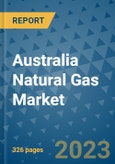Driving Demand for Natural Gas
One of the pivotal factors driving the surge in demand for natural gas in Australia is its increasing use as an alternative fuel in various applications. Natural gas's low environmental impact, coupled with Australia well-established distribution system, has made it an attractive and eco-friendly option for both residential and industrial purposes.Australia position as the world's largest producer of liquefied natural gas (LNG) has bolstered its allure for those concerned about fuel supply security and cost. The adoption of natural gas as an alternative fuel for transportation is also on the rise, with millions of natural gas vehicles (NGVs) and compressed natural gas (CNG) vehicles currently in use in Australia, thanks to its cost-effectiveness, environmental benefits, and widespread availability.
Expansion Plans in Australia Natural Gas Market
The expansion plans in Australia natural gas market present a plethora of benefits, including increased export potential, job creation, enhanced energy security, higher investments, and environmental advantages. These plans may involve the construction of new infrastructure, such as pipelines and liquefaction facilities, paving the way for new business opportunities in the construction and engineering sectors.To maintain competitiveness in the global natural gas market, Australian companies are also expected to invest in new technology and innovation, leading to more efficient extraction and production methods, as well as advancements in transportation technology. Expansion efforts could potentially lead to the negotiation of new international trade agreements, offering Australian natural gas producers increased market access and fostering long-term trading partnerships.
For instance, Chevron Corp's plans to expand its liquefied natural gas (LNG) operations in various regions, including Western Australia, Angola, Equatorial Guinea, the United States, and the Eastern Mediterranean, are indicative of the industry's growth potential.
Region-wise Analysis: Victoria's Dominance
Victoria stands out as a significant player in Australia natural gas production landscape for several reasons. The state boasts access to substantial natural gas reserves, including the prolific Bass Strait fields, which have been producing gas since the 1960s. Victoria's strategic location near major demand centers like Melbourne and Sydney makes it a cost-effective and reliable supplier.Furthermore, Victoria's robust infrastructure, including pipelines, processing facilities, and storage facilities, ensures the efficient and secure delivery of natural gas to customers, even during periods of high demand or supply disruptions. Government support and substantial investments in technology have further solidified Victoria's dominance in the Australian natural gas market.
Category-wise Insights: Methane Gas Takes Center Stage
In the Australian natural gas landscape, methane gas reigns supreme, constituting a significant proportion of the gas produced and consumed. Methane, the primary component of natural gas, accounts for approximately 70% to 90% of its composition. Australia primarily extracts methane gas from conventional natural gas reservoirs in regions like the North West Shelf, Bass Strait, and Cooper Basin.Methane gas finds extensive use in electricity generation, heating and cooling, industrial processes, and as a feedstock for chemical and fertilizer production. Recent years have witnessed a growing interest in methane gas for transportation fuel, with the development of compressed natural gas (CNG) and liquefied natural gas (LNG) vehicles.
Leading Market Share: Competitive Landscape
In Australia natural gas market, leading manufacturers command a substantial market share of 65% to 70%, hinting at an increasingly consolidated market. Key players in the Australian market are continuously enhancing their production capacity and expanding their product range.The competitive landscape is subject to government regulations, especially concerning environmental and safety standards, and can be influenced by global trends and shifts in demand, supply, and prices.
Key Companies Profiled:
- Gazprom
- ExxonMobil Corporation
- China National Petroleum Corporation
- Royal Dutch Shell PLC
- BP PLC
- Chevron
- Total S.A.
- Statoil ASA
- Conoco Philips
- Eni S.p.A.
- EOG Resources
- Encana
- Cimarex Energy
- Exco Resources
- EQT
- Chesapeake Energy
- Hess Corp.
- SM Energy Company
- Anadarko Petroleum
Key Segments of Australia Natural Gas Industry Research
By Type:
- Ethane
- Propane
- Methane
- Others
By Source:
- Conventional Gas
- Unconventional Gas
By Application:
- Automotive Fuel
- LCVs
- HCVs
- Power Generation
- Residential and Commercial
- Heating
- Cooking Gas
- Appliances
- Others
- Industrial Fuel
- Mining & Metallurgy
- Chemicals & Petrochemicals
- Paper & Pulp
- Food & Tobacco
- Others
- Others
By Region:
- New South Wales
- Queensland
- South Australia
- Tasmania
- Victoria
- Western Australia
- Northern Territory
This product will be delivered within 1-3 business days.
Table of Contents
Companies Mentioned
- Gazprom
- Exxon Mobil Corporation
- China National Petroleum Corporation
- Royal Dutch Shell Plc
- BP Plc
- Chevron
- Total S.A.
- Statoil ASA
- Conoco Philips
- Eni.SpA
- EOG Resources
- Encana
- Cimarex Energy
- Exco Resources
- EQT
- Chesapeake Energy
- Hess Corp.
- SM Energy Company
- Anadarko Petroleum
Methodology

LOADING...








